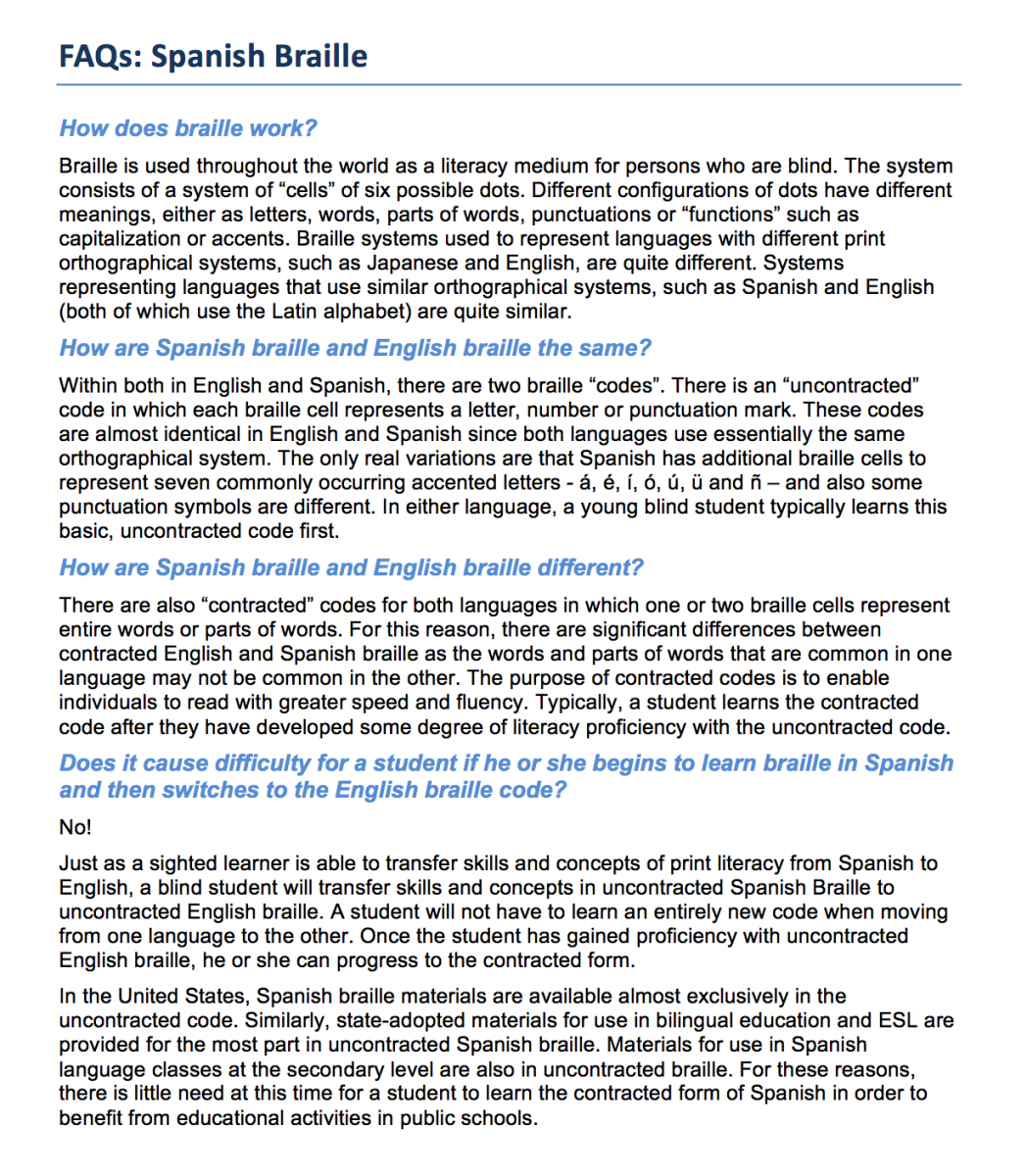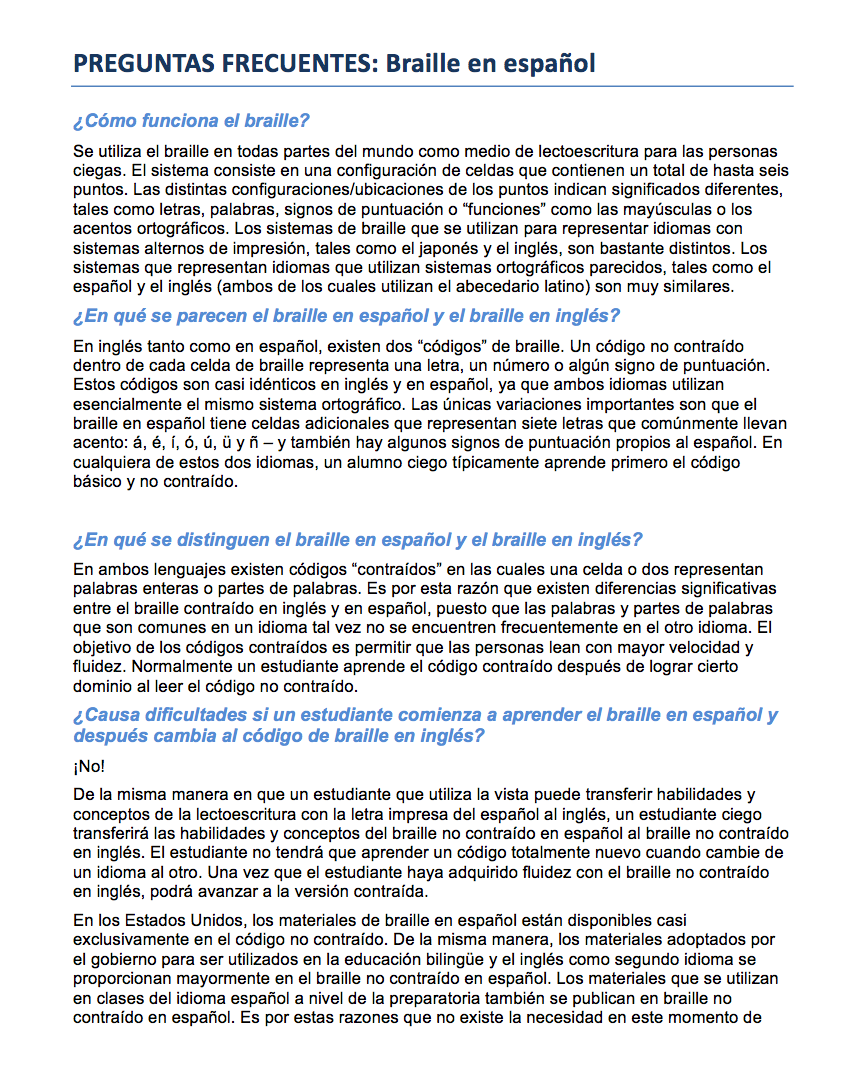Spanish Braille and English Language Learners
In a nation with a large immigrant population, issues regarding bilingual education for learners with visual impairment arise on a regular basis. As children from Latin American backgrounds continue to comprise the majority of students with limited English proficiency in this country, Spanish is the language that is most commonly involved in these situations.
Language can have significant impact on any area of the Expanded Core Curriculum, of course, but it is addressing early literacy for functionally blind, Spanish-speaking students that often appears to be particularly daunting for school staff and families alike. Bilingual education teachers have concerns that they do not know braille. Teachers of students with visual impairment worry about their lack of knowledge and experience in bilingual education. Families may wonder if learning braille should take precedence over their child’s need for native language instruction.
I’ve found these concerns are often based on limited familiarity with the Spanish braille code and how it compares to Unified English Braille. For the purposes of early braille acquisition, it is helpful to remember that the uncontracted versions of the two codes are virtually identical. Both employ the same dot configurations for all letters of the alphabet as well as most function symbols. Spanish does have an additional set of seven symbols for accented letters (á, é, í, ó, ú, ü and ñ) there are some differences in formatting that reflect differences in the two written languages (such as Spanish having question marks and exclamation marks both before and after text). Due to the close similarity in the two codes, literacy skills gained in Spanish braille will transfer to use in English braille with relative ease.
The contracted forms do have significant differences but at this time these do not have significant relevance for primary education programs since contracted Spanish braille materials are not widely available in this country.
Below are some common concerns and misconceptions that I’ve encountered when addressing braille issues regarding Spanish-speaking students. By sharing this document with teachers and administrators, it will hopefully make clearer the relationship between Spanish braille and UEB and assuage some of the worries they may feel. I am currently working on a Spanish version of the document that can be shared with parents as well.
FAQs: Spanish Braille
How does braille work?
Braille is used throughout the world as a literacy medium for persons who are blind. The system consists of a system of “cells” of six possible dots. Different configurations of dots have different meanings, either as letters, words, parts of words, punctuation or “functions”, such as capitalization or accents. Braille systems used to represent languages with different print orthographical systems, such as Japanese and English, are quite different. Systems representing languages that use similar orthographical systems, such as Spanish and English (both of which use the Latin alphabet) are quite similar.
How are Spanish braille and English braille the same?
Within both English and Spanish, there are two braille “codes”. There is an “uncontracted” code in which each braille cell represents a letter, number or punctuation mark. These codes are almost identical in English and Spanish since both languages use essentially the same orthographical system. The only real variations are that Spanish has additional braille cells to represent seven commonly occurring accented letters - á, é, í, ó, ú, ü and ñ – and also some punctuation symbols are different. In either language, a young blind student typically learns this basic, uncontracted code first.
How are Spanish braille and English braille different?
There are also “contracted” codes for both languages in which one or two braille cells represent entire words or parts of words. For this reason, there are significant differences between contracted English and Spanish braille, as the words and parts of words that are common in one language may not be common in the other. The purpose of contracted codes is to enable individuals to read with greater speed and fluency. Typically, a student learns the contracted code after they have developed some degree of literacy proficiency with the uncontracted code.
Does it cause difficulty for a student if he or she begins to learn braille in Spanish and then switches to the English braille code?
No!
Just as a sighted learner is able to transfer skills and concepts of print literacy from Spanish to English, a blind student will transfer skills and concepts in uncontracted Spanish braille to uncontracted English braille. A student will not have to learn an entirely new code when moving from one language to the other. Once the student has gained proficiency with uncontracted English braille, he or she can progress to the contracted form.
In the United States, Spanish braille materials are available almost exclusively in the uncontracted code. Similarly, state-adopted materials for use in bilingual education and ESL are provided for the most part in uncontracted Spanish braille. Materials for use in Spanish language classes at the secondary level are also in uncontracted braille. For these reasons, there is little need at this time for a student to learn the contracted form of Spanish in order to benefit from educational activities in public schools.
Can a TVI who does not speak Spanish teach braille to a student with limited English proficiency who is being taught in bilingual education classes?
Yes!
Every student for whom braille has been identified as his or her primary learning media must receive services from a certified teacher for students with visual impairment (TVI). The role of the TVI is to ensure that the student gains proficiency in the braille code. In situations in which a TVI does not have fluency in Spanish and is working with a student with limited English skills, the TVI should collaborate with a bilingual paraprofessional or volunteer to address the language needs of the student during braille lessons.
The TVI is not responsible for teaching academic subjects, such as language arts, science and math, to the braille student; this is the role of the classroom teacher. The classroom teacher is not responsible for teaching the student braille; this is the role of the TVI. With sufficient braille proficiency, the student is able to access all classroom materials provided by the classroom teacher, assuming these materials have been transcribed into braille. The classroom teacher is responsible for providing materials to the TVI prior to presenting them in her lessons with reasonable time so that they may be transcribed. Student responses will be done in braille and will also need to be transcribed to print, by the TVI, so that the classroom teacher can monitor the student’s work.
Because of the close similarities between English and Spanish braille, the TVI will be able to transcribe materials with minimal difficulty. There are a number of easy-to-read Spanish braille “cheat sheets” that provide a quick reference for a TVI working in this situation. Some example can be found at:
- Hadley School: www.hadley.edu/Resources_list/spanishbraille.docx
- Word Press: https://spanishbraille.wordpress.com/2009/04/29/spanish-braille-cheat-sh...
To ensure that a blind student with limited English proficiency acquires proficiency in braille and is fully integrated into general education classes, all members of the educational team should have a clear understanding of their respective roles and work together in a collaborative approach. The situation does present certain challenges, but these can be met and surmounted through ongoing communication and cooperation.
FAQs: Spanish Braille
Download FAQs: Spanish Braille (Word doc).
PREGUNTAS FRECUENTES: Braille en español
Download PREGUNTAS FRECUENTES: Braille en español (Word doc).




Comments
Spanish Braille & ELL